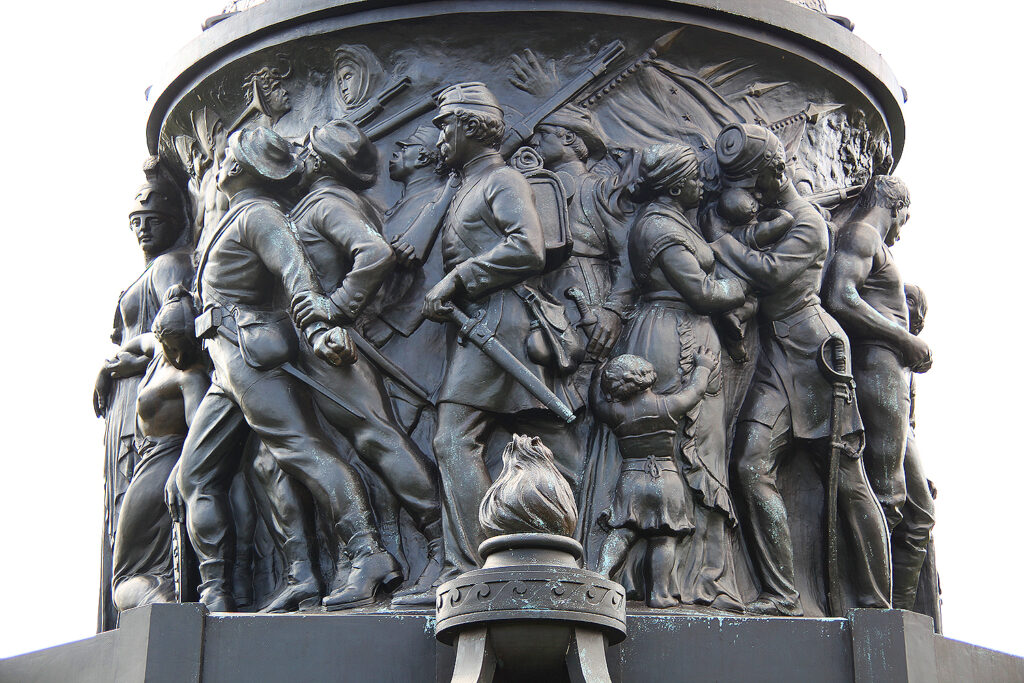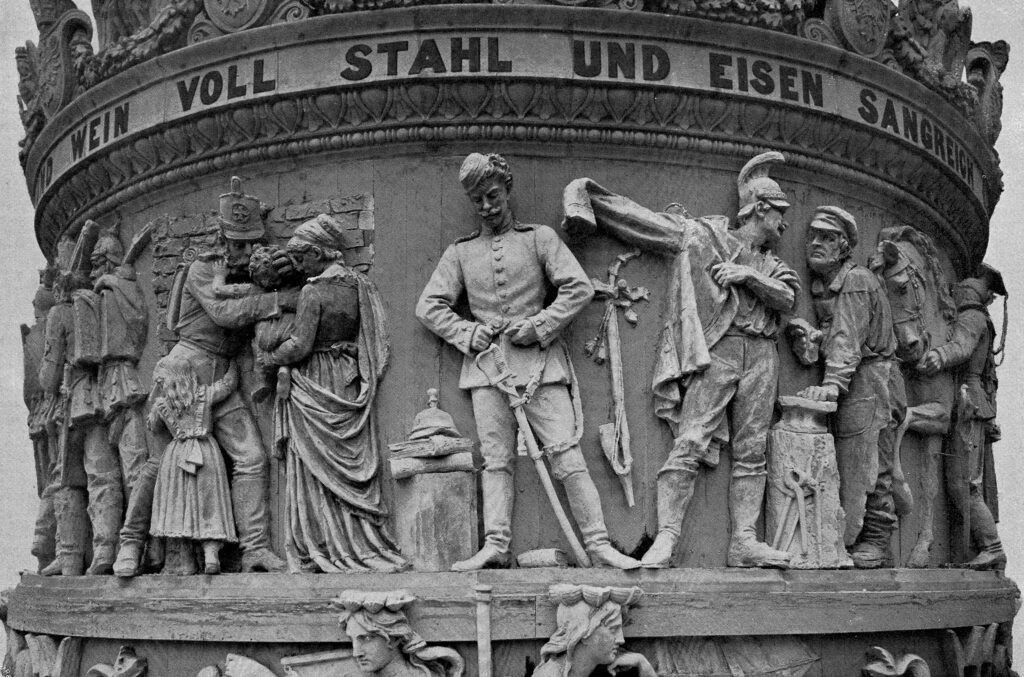Jim Webb, a former U.S. senator from Virginia, former secretary of the Navy, man of letters, and a Vietnam platoon leader with a heroic combat record, recently rendered a public service in coming to the defense of the endangered century-old Confederate Memorial at Arlington National Cemetery in a Wall Street Journal commentary. “I cannot imagine,” Webb wrote, “that the removal of this memorial, conceived and built with the sole purpose of healing the wounds of the Civil War and restoring national harmony, could be within the intent of a sweeping sentence placed inside a nearly trillion-dollar piece of legislation.” The legislation in question being the National Defense Authorization Act of 2021.
The response from those seeking the memorial’s removal, starting with the vice-chair of the NDAA-created “naming commission” that recommended it, was standard fare. The memorial, currently slated for removal by the end of the year, is a tribute to “an enemy who chose treason to preserve slavery” and “celebrate[s] white supremacy,” declared Brigadier General Ty Seidule, a former West Point history professor. Another letter to the editor recommended following the German example in dealing with the Holocaust’s legacy, accompanied by the predictable syllogism: No monuments to Nazis, no monuments to Confederates.
Wait a second—enslaved African-Americans underwent a Holocaust? According to Wilfred McClay’s sweeping one-volume history of the United States, Land of Hope (2019), they experienced the largest natural increase of any slave population in history. This doesn’t minimize the evil aspects of slavery, including the brutal Middle Passage and the cruelly unchristian practice of separating families. But the idea that American chattel slavery ranks with the Holocaust in the annals of infamy is unsupportable.
A West Point professor, moreover, might be expected to treat the “treason” issue with a lot more nuance. Traitors to what? In the South, the idea that one’s allegiance was owed first and foremost to one’s native state as opposed to the Union was deeply ingrained. The Constitution did not forbid secession. If it had, it almost certainly would not have been ratified. As legal scholar F.H. Buckley has reminded us, the Father of the Constitution, James Madison, was instrumental in having Virginia proclaim its right, when it ratified the document, to withdraw from the Union if Virginia suffered “injury or oppression” at the hands of the federal government.
As Webb notes, only a tiny percentage of Confederate warriors were slaveowners, while less than a quarter of them benefited from the slave economy. It is hard to believe that Dixie’s fighting men put their lives on the line simply to defend the Peculiar Institution. The more logical supposition would be that they put their lives on the line to resist what they regarded as an invasion, which certainly qualifies as “injury or oppression.”

A grassroots campaign has coalesced to prevent the Confederate Memorial’s cancellation. An amendment to a pending defense appropriations bill, proposed by Georgia Republican Rep. Andrew Clyde, would deny funding for the removal. It is slated to be taken up by the Rules Committee next week. Virginia Governor Glenn Youngkin, a rising star in the Republican party, opposes the monument’s banishment. Let’s hope he speaks out in favor of Clyde’s amendment. Two federal lawsuits contesting Defense Secretary Lloyd Austin’s approval of the removal have been filed. Both contend the monument is a grave marker outside the Naming Commission’s purview. They also assert that instead of doing due statutory diligence to determine whether the monument should be banished, Austin illegally jumped ahead to the question of how it should be dismantled and removed, and where it should be taken.
The sculptor of the Confederate Memorial, Moses Jacob Ezekiel, was a VMI graduate of Sephardic Jewish ancestry and a Confederate combat veteran, who received sophisticated artistic training in Berlin before taking up residence in Rome. Ezekiel thought his monument’s iconographic program through carefully, loosely modeling its design on a temporary, wood-and-plaster monument to Teutonic triumph in the Franco-Prussian war by Ezekiel’s friend Rudolf Siemering, creator of Philadelphia’s spectacular tribute to George Washington (1897).
The Arlington monument—a bronze superstructure erected on a granite plinth—features a frieze with over 30 life-size figures, mostly in deep relief. It is crowned by an idealized female figure symbolizing the New South. Looking over the graves of Confederate veterans below, she extends a laurel branch in one hand while the other clasps the butt of a plow and a pruning hook. Isaiah’s “swords into plowshares” verse is inscribed below. On the circular frieze further down, warriors surge towards a helmeted Athena, aligned with the crowning ideal figure and supporting a fainting female figure of the Old South, whose shield reads “The Constitution.” Furies sound the trumpet blast of war. The relief’s dynamic panoply of figures attracts the approaching viewer while contrasting with the New South’s more static, timeless pose.
The New South figure symbolizes a future that takes stock of the past. The relief, in turn, offers an elegiac portrayal of the Confederacy. Most unusually for a Confederate monument, it acknowledges the existence of slavery, but in decidedly romantic terms. A uniformed black body servant proudly follows his master to war and a black “mammy” holds up an infant for her departing master, who is in uniform, to kiss. The latter vignette appears to have been inspired by Siemering’s temporary monument. Portraying the relief, which is purely retrospective in character, as an advertisement for white supremacy strikes me as far-fetched, but perhaps it should be left to visitors to decide for themselves, instead of banishing the monument to museological purgatory in order to calm the ideological ravings of our latter-day enrages.
From an artistic standpoint, Ezekiel’s Confederate Memorial ranks high among the nation’s Civil War monuments, but more on account of its overall design than its somewhat uneven figure work. His formal approach to composition was apt to be considered outdated in comparison with the more pictorially-oriented naturalism that infused Augustus Saint Gaudens’ Robert Gould Shaw Memorial on the Boston Common (1897), which portrays the mounted commander of the 54th Massachusetts and his African-American troops on the march. But as I’ve noted, a circular frieze with figures in relief poses a daunting artistic challenge.

The 2021 National Defense Authorization Act that established the Naming Commission forbids removal of grave markers. But that is what Ezekiel’s Confederate Memorial is. It is located at the center of Arlington Cemetery’s Section 16, where—exceptionally—nearly 500 graves of Confederate veterans and their widows, along with unknowns and a smattering of civilians, are arranged concentrically rather than in the familiar rows. The crowning figure looks downward toward the graves as she extends the laurel wreath. This pose would not make sense in the graves’ absence. This is a 32 ½-foot-tall funereal monument that serves as a grave marker. In the latter capacity it beckons visitors to the Confederate section. Removing the monument would be sacrilege as well as an insult to the memory of Moses Ezekiel, who is buried at the foot of what he considered his masterwork, adjacent to a bronze buttress surmounted by a flaming memorial urn.
Subscribe Today
Get weekly emails in your inbox
The monument’s removal is belatedly undergoing review in accordance with the National Historic Preservation Act and the National Environmental Protection Act. The review processes these laws prescribe are cumbersome and it is doubtful they can be properly completed before the end of the year, the deadline for execution of the Naming Commission’s approved recommendations. (The Secretary of the Army, however, is said to have discretionary authority to extend the deadline, Arlington Cemetery being an army bailiwick.) The NHPA process for proposed actions bearing on federally-owned historic properties—Ezekiel’s monument has been designated a contributing element to the historic cemetery landscape—requires determination of an “Area of Potential Effects” before final decisions on those actions are reached. A geographic area that would certainly be grievously affected is the great civic-art ensemble that includes the Lincoln Memorial, Arlington Memorial Bridge, Arlington House, and Arlington National Cemetery itself. This monumental ensemble symbolizes the reconciliation of North and South reflected in the resumption of military service by Southerners in the Spanish-American War.
The 1901 Senate Park Commission plan that extended the National Mall to the Lincoln Memorial included a monumental bridge on axis with Arlington House and the cemetery. Designed by the British-born George Hadfield and completed in 1818, Arlington House was for 30 years the home of Robert E. Lee, and was officially designated a national memorial to Lee in 1955. It was occupied by Union troops at the Civil War’s onset, and in 1864 the gorgeous surrounding landscape was given over to the creation of a military cemetery. Arlington House’s monumental Doric portico is readily visible from the other side of the Potomac, and the moment you reach Arlington Memorial Bridge (1932) from the Washington side, the manse comes sharply into focus.
When detailed discussions concerning the future bridge got underway in the early 1920s, it was referred to as the “Lincoln-Lee Bridge.” The federal government had already reserved Section 16 at Arlington Cemetery for Confederate burials and authorized the erection of Ezekiel’s monument, which was completed in 1914, in the same spirit of reconciliation. It is lunacy to cancel historic landmarks that tell us where we have been as a polity and a culture on our long and winding road to a more perfect union. A simple recommendation for Secretary Austin: Leave the danged monument alone.



















































